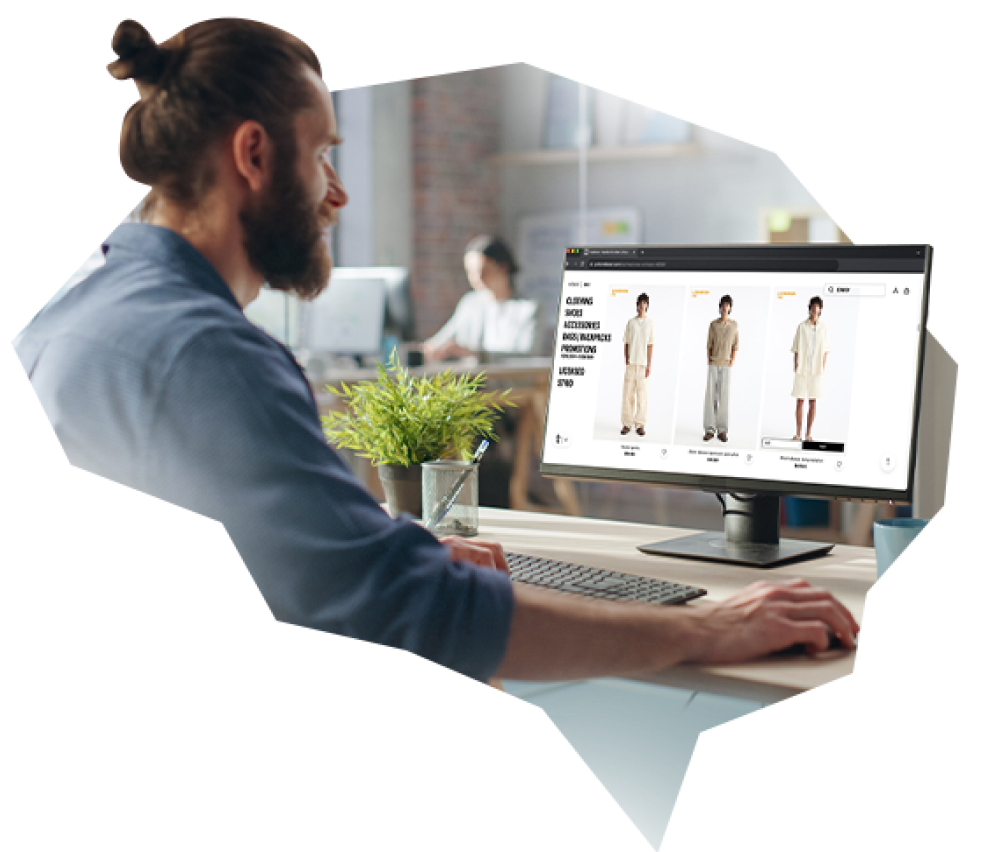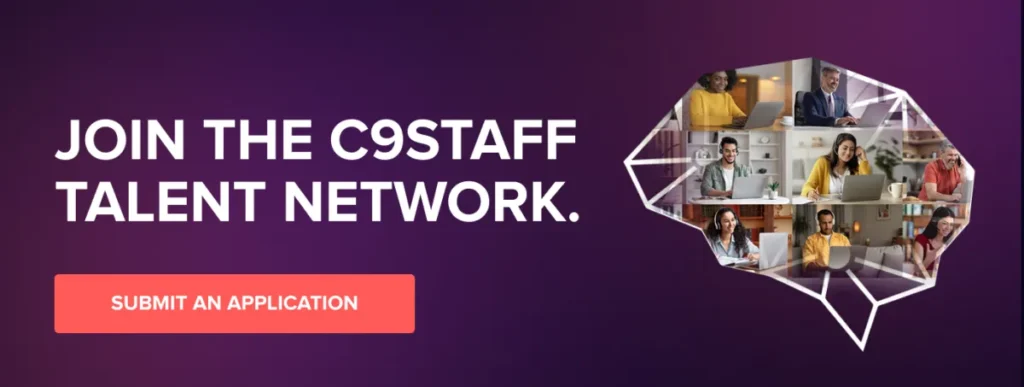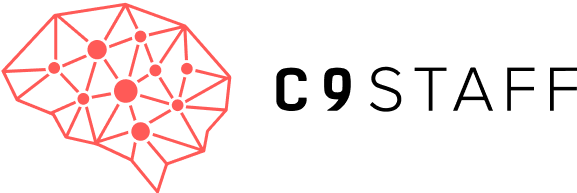Introduction

In today’s technology-driven world, the power of User Experience (UX) research cannot be overstated. UX researchers are at the forefront of designing products and services that not only function seamlessly but also resonate deeply with user needs and expectations. Their work is transformative, turning ordinary interactions into exceptional experiences that reflect and respect the user’s voice.
Employers seeking the optimal foundation for crafting precise and effective hiring specifications will find exceptional value in our complimentary User Experience Researcher Job Description template. This document, available for direct download below, encapsulates the core principles and best practices of C9Staff’s renowned hiring methodology. Tailored to help you attract top-tier candidates, our template ensures that your job description not only meets industry standards but also aligns seamlessly with your organizational goals.
User Experience Researcher Job Description Template

UX researchers shoulder a significant responsibility. From the earliest stages of product conception to the final phases of execution, they serve as the linchpin in product development teams. By blending scientific rigor with creative problem-solving, these professionals ensure that user needs are not just considered but are the guiding force behind every design decision. This approach results in products that are not only more effective but also inherently user-friendly, setting a standard for innovation and utility.
This article invites you to dig deeper into the world of UX research. Whether you are looking to hire, aspiring to become, or simply wish to understand the role of a UX researcher, this guide offers comprehensive insights into crafting and deciphering job descriptions that capture the essence of this pivotal role. Prepare to explore the nuances that make a proficient UX researcher and gain a deeper appreciation of the skills and demands of this dynamic field.
As we proceed, expect an in-depth exploration of the roles, skills, and industry demands that shape the career of a UX researcher. This introduction lays the foundation for a comprehensive understanding that will guide you through the complexities of the UX research field, seamlessly transitioning into the detailed discussions to come.
Exploring UX Research: Roles, Responsibilities & Your Path to Becoming a UX Researcher
Who is a User Experience Researcher?

User Experience (UX) researchers are pivotal in developing products and services that aren’t just efficient but also resonate emotionally with users. They act as vital bridges between the technical functionalities of a product and the human elements that make it both accessible and enjoyable. These professionals use their skills to ensure that technological solutions cater not only to practical needs but also to the emotional and experiential demands of the user base.
The responsibilities of a UX researcher are comprehensive and crucial to the design process. Key tasks include conducting user interviews, creating detailed user personas, performing usability testing, and analyzing user feedback. Each of these tasks plays a significant role in gathering and interpreting the data necessary to guide design decisions. By creating user personas, UX researchers can bring hypothetical users to life, providing the design team with clear archetypes to consider. Usability testing further allows researchers to pinpoint where a product might falter in real-world scenarios, making their role critical in refining the user experience before a product’s final release.
As you read this, consider the depth of insight and strategic thinking that UX researchers bring to a tech team. Their ability to translate complex user data into actionable design strategies is crucial for developing products that not only meet but exceed customer expectations. They delve into the psyche of the user, transforming raw data into valuable insights that lead to products which are not just usable, but delightful.
Essential Skills and Qualifications

Core skills are the foundation of a successful User Experience (UX) researcher. Analytical thinking is paramount, as it enables these professionals to interpret vast amounts of data and draw meaningful insights that directly inform design decisions. Such capabilities ensure that products not only meet functional requirements but also deliver on user expectations, enhancing overall satisfaction and usability.
User empathy is equally critical. This skill allows UX researchers to understand the emotional and practical needs of users, fostering the creation of intuitive and user-friendly designs. It involves stepping into the users’ shoes and using their perspective to guide product development, ensuring that the end result resonates on a personal level with its intended audience.
Technical proficiency with tools such as Sketch or Adobe XD is indispensable in this role. These tools are used for prototyping and presenting design solutions, allowing researchers to visualize and iterate on user feedback efficiently. Mastery of such tools ensures that UX researchers can effectively communicate their findings and proposed solutions to the rest of the product development team.
Moving on to educational requirements, a career in UX research is typically supported by academic backgrounds in psychology, human-computer interaction, design, or similar fields. These disciplines provide the theoretical and practical foundations necessary for understanding user behavior and designing effective user interfaces.
Certifications from recognized institutions like the Nielsen Norman Group or the Interaction Design Foundation also play a crucial role in enhancing a UX researcher’s qualifications and credibility. These certifications demonstrate a commitment to ongoing professional development and a deep understanding of the latest methodologies in UX research.
If you’re considering a career in UX research, you’ll find that a combination of the right education and hands-on experience with specific design tools can significantly bolster your chances of success. This path not only prepares you for the technical demands of the role but also enhances your ability to contribute strategically to product development.
By equipping yourself with these skills and qualifications, you position yourself as a valuable asset to any tech team, capable of guiding product strategies that are both innovative and user-centered. As we explore further into crafting effective job descriptions and advancing in a UX career, keep in mind that the core competencies discussed here are just the starting point for a successful journey in the dynamic field of UX research.
Job Seekers: Navigating Your Career as a User Experience Researcher

The role of a User Experience (UX) researcher is both dynamic and critical in the development of products and services that center around the user’s needs. Daily responsibilities vary widely but fundamentally involve conducting user interviews to gather insights, performing usability tests to evaluate product interfaces, analyzing data to draw meaningful conclusions, and collaborating with design teams to integrate these insights into practical design solutions. This multifaceted role requires a UX researcher to adapt quickly and apply a variety of skills to ensure that the end product resonates with and meets the needs of the target audience.
As you consider a career in UX research, preparation is key. Educational pathways typically include degrees in fields like human-computer interaction, psychology, or graphic design, which provide foundational knowledge and relevant skills. However, beyond formal education, acquiring specific skills such as analytical thinking, empathy, and proficiency with UX design tools like Sketch or Adobe XD is crucial. Developing a robust portfolio that showcases a range of projects—from wireframes to user flows—demonstrates your ability to apply UX principles effectively and is essential for standing out in the job market.
When searching for a job as a UX researcher, it’s important to align your search with your skills and career aspirations. Networking plays a vital role in uncovering opportunities and can be facilitated through platforms like LinkedIn or industry-specific job boards. Attend industry conferences and participate in online forums to connect with potential employers and peers. When evaluating job offers, consider not just the salary but also the company culture, the potential for growth, and the opportunities to work on projects that excite you.
Excelling in job interviews for UX research positions requires a clear articulation of your experiences and skills. Be prepared to answer common questions such as, “How do you handle negative feedback on your designs?” or “Can you describe a project where your research significantly influenced the product outcome?” Demonstrating a user-centered thinking process and the ability to communicate complex information succinctly will set you apart.
Finally, career growth and advancement in UX research demand continuous learning and professional development. Seek out workshops, earn certifications, and attend conferences to stay current with the latest trends and technologies in the field. Consider finding a mentor who can provide guidance and support as you navigate through different career stages. Engaging in these activities not only enhances your skill set but also opens up opportunities for advancement from junior roles to senior UX researcher positions and beyond.
By actively managing your career and staying informed about the latest developments in UX research, you equip yourself with the tools necessary to succeed and make a significant impact in your field. This comprehensive approach ensures that you are not only prepared to enter the job market but also to thrive and advance within it.
If you’re ready to supercharge your career and land your dream job, C9Staff is here to help. Submit your resume to our talent acquisition department, and if your qualifications align with our client’s requirements, we’ll reach out to discuss potential opportunities that match your skills and aspirations. Don’t miss the chance to advance your career with the support of C9Staff’s extensive network and resources. Take the first step towards your future success by submitting your resume today!

Crafting the Perfect UX Researcher Job Description

Crafting a precise and informative job description is pivotal in attracting the right candidates for the role of a User Experience (UX) Researcher. For employers and HR professionals, understanding that the quality of your job description can significantly impact the caliber of applicants is crucial. A well-crafted job description serves not only as a beacon to attract ideal candidates but also as a filter to ensure that those who apply are well-suited for the responsibilities they will undertake.
Step-by-Step Guide to Writing an Effective UX Researcher Job Description:
Job Title and Summary: Begin with a clear and descriptive job title that reflects the core duties of the role. The summary should provide a snapshot of what the job entails and how it fits into the organizational structure. Emphasize the company’s culture and values to attract candidates who share similar ideals and are more likely to thrive within your team.
Key Responsibilities: Clearly list the primary duties of the UX researcher in a bullet-point format to enhance readability. Include responsibilities such as:
Conducting comprehensive usability tests to gauge user satisfaction.
Analyzing user behavior to propose improvements for product development.
Collaborating closely with design and development teams to ensure that user insights are integrated into product enhancements. Ensure these responsibilities align with the strategic goals of your organization, highlighting how they contribute to the overall success of your products and services.
Skills and Qualifications: Detail the necessary skills and qualifications for the role, building on the insights from the previous section about essential skills like analytical thinking and user empathy. Incorporate SEO-friendly keywords such as “user empathy,” “analytical skills,” “usability testing,” and “prototyping.” These keywords not only help the job description perform better on search engines but also attract candidates with specific expertise pertinent to the role.
SEO Tips: Use relevant keywords throughout the job description to enhance its visibility on job boards and search engines. Advise on integrating these terms naturally within the text to maintain readability and engagement without compromising professional tone or clarity.
Employers seeking the optimal foundation for crafting precise and effective hiring specifications will find exceptional value in our complimentary User Experience Researcher Job Description template. This document, available for direct download below, encapsulates the core principles and best practices of C9Staff’s renowned hiring methodology. Tailored to help you attract top-tier candidates, our template ensures that your job description not only meets industry standards but also aligns seamlessly with your organizational goals.
User Experience Researcher Job Description Template

The UX Researcher's Toolkit

In the dynamic field of user experience (UX) research, the tools and software used are as critical as the insights they provide. Platforms like UsabilityHub and Lookback.io are fundamental for gathering real-time user feedback and testing the usability of products at different development stages. These tools enable UX researchers to capture direct input from users, providing a deeper understanding of user interactions and preferences that are crucial for refining product designs.
For UX researchers, a variety of tools are available that cater to different aspects of the research process. Prototyping software such as Sketch and Adobe XD plays a vital role in visualizing new ideas and facilitating iterative changes based on user feedback. These tools help translate user data into actionable design improvements quickly and efficiently. Additionally, analytics tools like Hotjar and Google Analytics provide invaluable insights into user behavior on websites or applications, helping researchers identify patterns and areas for enhancement.
As you explore these tools, consider how each can be integrated into your current UX research processes to enhance productivity and insight. The capability to adapt and utilize these tools effectively can significantly impact the success of your projects.
Emerging technologies are also reshaping the toolkit available to UX researchers. Innovations in AI-driven analytics allow for more precise data analysis and trend prediction, enhancing the ability to make data-driven decisions. Virtual reality (VR) offers new avenues for immersive user testing, providing a deeper understanding of user reactions in simulated environments. Furthermore, advanced biometric tools that measure physiological responses—such as eye movement and heart rate—offer a window into the user’s subconscious experience with design elements, paving the way for highly intuitive user interfaces.
To stay competitive and effective in your role as a UX researcher, it is crucial to keep abreast of these developments. Continuously exploring new software and methods not only enhances your toolkit but also contributes significantly to the success of the products you design. Remember, mastering these tools does more than just refine your skill set—it also positions you at the forefront of creating user-centered designs that truly resonate with users.
Top 10 Essential UX Research Tools: Master User Research Like a Pro!
Career Path and Advancement

The career trajectory of UX researchers can significantly vary depending on the type of organization they work for. In startups, UX researchers often wear multiple hats, tackling a broad range of responsibilities from user testing to data analysis, which provides a rapid, hands-on learning curve. Conversely, in mid-sized companies, UX researchers might find more specialized roles but with opportunities to influence broader product design decisions. In large corporations, UX researchers typically see a well-defined career ladder that offers progression from junior roles to senior management positions, where the focus shifts towards strategic oversight and leading research teams.
For UX researchers, continuous professional development is vital for career advancement. Engaging in ongoing learning through online courses, specialized workshops, and obtaining industry-recognized certifications are essential for keeping pace with the fast-evolving field. These resources not only refine your skills but also broaden your understanding of new methodologies, tools, and user behavior insights.
As you consider your career trajectory in UX research, think about the specific skills and experiences you aim to acquire and how they align with your long-term professional goals. It’s not just about moving up the ladder but ensuring each step enhances your capability and influence in the field.
Networking and mentorship play crucial roles in your career development. Attending UX conferences, joining professional organizations like the User Experience Professionals Association (UXPA), and participating in online forums and social media groups dedicated to UX research are excellent ways to connect with peers and mentors who can provide guidance and opportunities.
Understanding the Market: Salary & Demand

The compensation for User Experience (UX) researchers can vary significantly depending on several key factors, including geographic location, experience level, and the type of organization. For instance, entry-level UX researchers in startup environments may start with salaries around $60,000 annually, whereas more experienced researchers in large corporations can command upwards of $130,000 or more. Notably, tech hubs like Silicon Valley, New York City, and Seattle offer some of the highest salary ranges due to their concentrated demand for UX professionals.
Educational background, specialized skills, and industry experience play pivotal roles in determining a UX researcher’s compensation. A deeper proficiency in UX tools and methodologies, such as user testing, wireframing, and prototyping with tools like Sketch and Adobe XD, can enhance a researcher’s marketability and potential salary. Additionally, UX researchers with advanced degrees in fields like human-computer interaction, psychology, or design often have a competitive edge in securing higher-paying positions.
If you’re entering the UX field, understanding how these different factors influence salary can help you negotiate your compensation effectively. Knowing the worth of your skills and experience is crucial in ensuring that you receive fair remuneration for your work.
In terms of job market trends, industries such as technology, healthcare, and finance are seeing significant growth in demand for UX skills. Regions that are emerging as new tech hubs, including Austin, Denver, and Toronto, are also experiencing an upsurge in demand for UX talent, reflecting broader tech industry growth in these areas. This geographic expansion indicates a healthy and growing job market for UX professionals, who are increasingly recognized as essential to product development and user satisfaction.
Employers looking to elevate their recruitment process for the perfect User Experience Researcher are invited to discover how C9Staff can streamline your sourcing, hiring, training, and management needs. Click the link below to schedule a free exploratory call with one of our expert account managers today. During this call, we will attentively listen to your specific needs and provide endorsements for potential candidates at no cost, helping you evaluate the best talent available at competitive prices. Let us assist you in finding the ideal fit for your organization.

Conclusion

As we look to the future of UX research, it’s clear that technology advancements like AI, machine learning, and augmented reality are set to redefine the tools and methodologies UX researchers use. Emerging trends such as voice user interface design, emotional recognition technology, and a heightened focus on accessibility are shaping the field, creating new opportunities and challenges. These advancements promise to make UX research more dynamic and insightful, enabling researchers to delve deeper into user interactions and enhance the usability of products.
For those aspiring to carve out a career in UX research, staying ahead means continuously updating your skills and embracing these new technologies. Engage actively in learning new research methodologies through tech workshops, advanced courses related to emerging trends, and by joining tech-focused UX communities. Such proactive learning will equip you with the knowledge and tools to thrive in a rapidly evolving field.
As you forge your path in UX research, remember the importance of staying informed and adaptable to the changing landscape of technology and user needs. The strategic role of UX researchers in the tech ecosystem cannot be overstated—they are pivotal in crafting experiences that not only function seamlessly but also connect emotionally with users, thereby enhancing overall satisfaction and engagement.
In conclusion, the evolving field of UX research is a cornerstone of innovation and user satisfaction in the tech industry. By understanding the impact of emerging trends and preparing accordingly, you can position yourself to make significant contributions to this dynamic field. Reflect on how you can leverage your skills and knowledge to drive forward the principles of user-centered design and continue to shape the future of technology.




